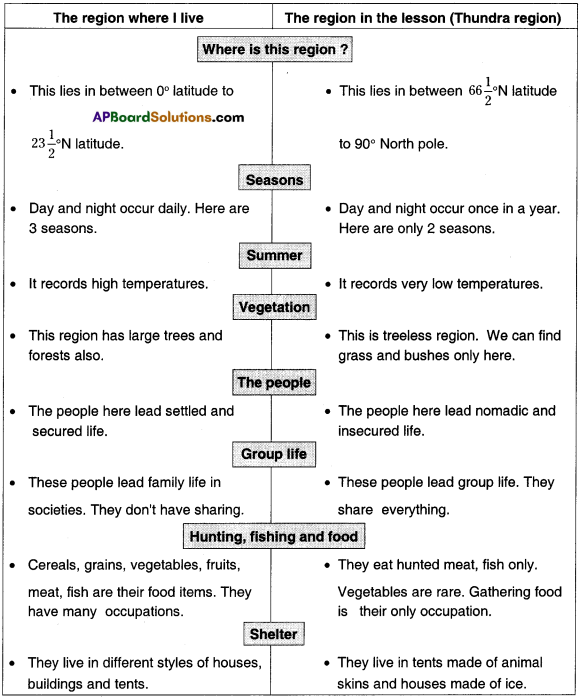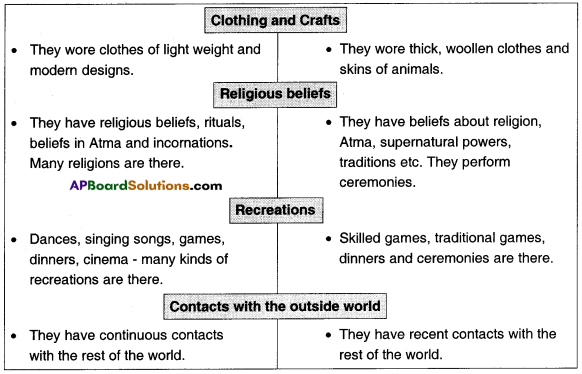SCERT AP Board 8th Class Social Solutions 8th Lesson Impact of Technology on Livelihoods Textbook Questions and Answers.
AP State Syllabus 8th Class Social Studies Solutions 8th Lesson Impact of Technology on Livelihoods
8th Class Social Studies 8th Lesson Impact of Technology on Livelihoods Textbook Questions and Answers
Question 1.
Narahari created the following list of activities where technology is not used. Do you agree with him? If not, prove him wrong.
a) While singing a song
b) While cooking idli
c) While performing drama on the stage
d) While making garland for sale
Answer:
I do not agree with Narahari. I think his words are wrong.
Technology is the practical application of knowledge in our everyday lives that leads to a new product or an improvement in the way something works or how something is done. There is no question of this and that. It is useful in all the activities.
![]()
Question 2.
Describe how the situation of labour has changed in powerlooms and mills. Do you think this change is beneficial to the labourers or to the owner? Give reasons for your answer.
Answer:
Textile mills have a large number of workers. They have workers’ unions or labourer unions. These unions fight for their rights and their better conditions. Powerlooms are small units. Compared to mills, powerlooms pay a very low salary. While mills pay workers monthly salary, workers in powerlooms are paid on piece rate basis. If there is any powercut, powerloom workers are not given salaries. Trade unions do not exist in most powerloom clusters. They have no pensions or other social security provisions.
Due to these reasons, we can say that this change is beneficial to the owners.
Question 3.
What are the advantages of using CHs? Who benefits most? Why do farmers use CH?
Answer:
Advantages of using CHs:
- CH harvests the crop, threshes and cleans the grian from chaff.
- Use of CH helps in timely harvest of paddy. It takes less time, reduces the crop loss and helps farmers to tackle the peak time labour shortage.
- It also saves from vagaries of weather in coastal regions of Tamil Nadu, Andhra Pradesh and Odisha.
- The farmers are able to sow the second crop without much delay.
- Their dependency on labourers is also reduced.
The farmers benefit most.
Due to excess benefits by using CH, the farmers are using these CHs.
![]()
Question 4.
Changes in technology lead to changes in job opportunities. Do you agree with this statement? Why?
Answer:
I agree with this statement.
Reason: Technology with skills creates new jobs.
e.g.: Many landline companies and mobile companies were started. These companies export these phones to many countries.
It created new jobs for young people to work in multi-national companies, producing mobile handsets, telephone booths, mobile sales, repair and recharge/top-up shops.
Question 5.
Prabhavathi feels that it is true that telephone technology has changed. She feels that new jobs are available to only educated persons. She also says that many people in India are not literate and hence modern technology is always biased to the educated. Do you agree with her? Give your reasons.
Answer:
I don’t agree with Prabhavathi.
Technology changed as she said, but it is useful to all. e.g.: Now fishermen, rickshaw pullers etc., are using cell phones.
With a minimum educational qualification so many are working as mechanics and technicians. Skill is needed in some works and technology instead of education.
![]()
Question 6.
In this chapter, changes in technology in three sectors are discussed. In the following table identify a different example for each of these sectors that is not discussed here:
| Sl.No. | Sector | Older technology | Newer technology | Any impact on livelihood/ amount of production/increase or decrease in human effort |
| 1 | Agriculture | |||
| 2 | Industry | |||
| 3 | Service |
Answer:
| Sl.No. | Sector | Older technology | Newer technology | Any impact on livelihood/ amount of production/increase or decrease in human effort |
| 1 | Agriculture | Transporting coal in trolleys in mines | Through conveyor belt. | Production increased, human effort decreased. |
| 2 | Industry | Techniques & Tricks old cameras in film industry | Computers, digital cams, graphics | Livelihood, amount of production increased, human effort decreased. |
| 3 | Service | Surface railway lines | Metro Railways | Human effort decreased. |
Question 7.
Read the paragraph under the heading “New Skills and New Jobs” and answer the following:
Many private companies including the government-owned ones provide both landline and mobile connections. Private companies continue to expand their share in the telecommunication services. Many companies are being established in India to manufacture handsets. These companies are now exporting to more than 80 countries around the world. The telephone/ mobile technology also came up with the need for new skills. It created new jobs for young people to work in multinational companies, producing mobile handsets, telephone booths, mobile sales, repair and recharge/ top-up shops.
What are the newly created jobs for young people in your area?
Answer:
Work in multinational companies, producing mobile handsets, telephone booths, mobile sales repair and recharge/top up shops are the newly created jobs for young people in our area.
![]()
Question 8.
Locate the following in the world map:
1) England 2) USA 3) India
Answer:

Question 9.
The people live in forest and adjacent to forest cannot afford to use latest technology. What measures do you suggest for improving their lives?
Answer:
We should not think using technology is only as improvement. The people living in forest and adjacent to forest are living in Nature’s lap. They are living in groups. All the blood relations live mostly in the same group. So they may not need phones or technology. The government should introduce technology to them. It should create better conditions to improve their lives. Then only they can lead an improvised life.
![]()
Project work
Mallaiah is a farmer in Sripuram village. There are about 100 houses in the village. Today all the work like planting, weeding, harvesting, spraying pesticides and fertilisers is done by machines. In olden days, it was all done manually. There are more than 33 tractors and about 15 harvesters available in his village. A few of them are given on hire. The owners of the tractors charge Rs. 300 per hour for tilling the fields. More and more farmers are now using these machines in their fields. Based on this information, create a wall paper with illustrations and possible discussions between different groups of people in the village.
Answer:
Wall Paper
a) Mr. Mallalah: I need a tractor on hire
Tractor Owner: How many acres to be ploughed?
Mr. Mallaiah: 3 acres.
Tractor Owner: For one hour, Rs. 300. When do you need?
Mr. Mallaiah: Today only.
Tractor Owner: I already agreed for others.
Mr. Mallaiah: I pay Rs. 400 per acre
Tractor Owner: 0k. I will send traàtor by evening.
b) Tractor Owner: Tractor is under repair.
Mechanic: What is the problem?
Tractor Owner: Tractor’s wheel is caught. It is not working.
Mechanic: Tractor lost bearings. It will cost Rs.1000/-
Tractor Owner: 0k repair it. I have many works.
Mechanic: Not now, by evening I will do it.
c) Old Man: In our days we used to do all these works manually.
Young man: What are the works?
Old Man: Sowing, ploughing and transplanting.
Young man: Today we need not do all works.
Old Man: Yes, you all have machines.
d) Farmer: Mastri, I need 30 labourers.
Mastri: For what work?
Farmer: For harvesting.
Mastri: Now we are not doing all these works.
Farmer: Why?
Mastrl: Now combined harvesters is going on.
Farmer: Is it available!
Mastri: Our charges are high it will be ready by tomorrow morning.
Farmer: I cant pay so much for labourers. I will wait for combined harvester.
8th Class Social Studies 8th Lesson Impact of Technology on Livelihoods InText Questions and Answers
![]()
Question 1.
What are the advantages of using CH (Combined Harvester) in agricultural production? Make a list from the above text. (Textbook Page No. 94)
Answer:
Advantages of using CH in agricultural production:
- CH is one of the important machines used for paddy harvest.
- It harvests the crop, threshes and cleans the grain from chaff.
- It helps in timely harvest of paddy.
- It takes less time, reduces the crop loss and helps farmers to tackle the peak time labour shortage.
- It also saves the crop from the vagaries of weather in coastal regions of Tamilnadu, Andhra Pradesh and Odisha.
- The farmers were able to sow the second crop.
- Their dependency on labour is also reduced.
Question 2.
List the jobs lost by agricultural labourers when Combined Harvesters are used. (Textbook Page No. 94)
Answer:
They lose the jobs of harvesting the crop, threshing and cleaning the grains from chaff when CHs are used.
![]()
Question 3.
Fill in the blanks: (Textbook Page No. 97)
i) The production of cloth is classified into four categories as mill, handlooms ———– and ———–.
ii) ———– state had the largest number of handlooms in 1988.
iii) ———– state had the largest number in 2009.
iv) Which state had the lowest number of handlooms in 2009?
v) The ———– pays the worker a salary while the ———– pays the workers on ———– rate.
Answer:
i) hosieries; powerlooms.
ii) Tamilnadu
iii) Tamilnadu
iv) Punjab
v) mill, powerloom, piece
Question 4.
Do you think it is appropriate to use CHs in India where a large section of people working in agriculture as labourers, are poor, and there is so much problem of rural unemployment? (Textbook Page No. 94)
Answer:
We can think in two angles about this problem.
We can say that it is not appropriate by keeping the following in view:
- Rural unemployment
- More dependency on agriculture. They may lose their livelihood.
- While keeping the development of the country in view – it is appropriate.
Extensive farm mechanisation is widely prevalent in developed countries. These human resources can be used in other sectors by providing various job opportunities. This helps the development of the country.
![]()
Question 5.
In this chapter, we saw the photos of many women engaged in technology. Many of them like the one above does not have an Engineering degree. Conduct a debate in classroom what biases/ stereotypes exist about women getting educated as engineers. (Textbook Page No. 99)
Answer:
“Women education brightens the future”. Degree is an acknowledgement to their knowledge. There are so many skilled persons in many areas without qualifications, e.g.: The village farmers have more knowledge than agricultural graduates.
If the women acquire Engineering graduation, they will get higher positions. They educate their families. They lead their families and nation to development.
Question 6.
Who were the contributors to this industrial revolution? (Textbook Page No. 90)
Answer:
| Inventions | Their inventors |
| 1. Spinning Jenny | James Hargraves |
| 2. Steam Engine | James Watt |
| 3. Steel Making | Henry Bessem |
| 4. Electricity and Light bulb | Thomas Aiwa Edison |
| 5. Telegraph | Samuel F.B. Morse |
| 6. Telephone | Alexander Grahambell etc. |
These persons were contributors to this industrial revolution.
![]()
Question 7.
Find out the story of the first steam engine. How did this lead to establishment of Railways in India? (Textbook Page No. 91)
Answer:
Steam Engines were used to pump water out of mines in England when James Watt was born. The discovery that steam could be harnessed and made to work is not credited to James Watt. We do not know that exactly who made that discovery, but we do know that the ancient Greeks had crude steam engines. James Watt however is credited with inventing the first practical steam engine. And so the history of the modern steam engine often begins with James Watt.
There were no railway lines in India upto 1850. It was almost 100 years to the British. Colonial rule in India. They need transport facilities in this vast country. So they inaugurated the first railway line in 1853 which ran from Bombay to Thana. Since then the distance is reduced in India.
Question 8.
It is argued that new jobs can be created in rural areas through infrastructure works. Link roads, tanks, bunds etc., can be created through labour intensive schemes. If you live in rural area, find out if any such activities are being done and discuss if these will suffice the livelihoods of the people there. (Textbook Page No. 94)
Answer:
A few years back the then government introduced a scheme ‘Food for Work’. Many works were undertaken in our village. Digging out soil from ‘Cheruvus’ is one of those works. They used this soil to lay roads. They used quarry dust also in laying roads. Digging drainage canals was also a work in this scheme. But the labourers were given ‘rice’ instead of money.
One cannot lead their life only with rice. So they started exchanging the rice with money. As a result the purpose of the scheme got sidetracked. Even then we can say that this scheme helped the labourers in rural areas. These are helpful to them in non-crop season.
![]()
Question 9.
How have computers changed the life around you? (Textbook Page No. 91)
Answer:
Computers have changed our lives in many different ways and aspects. Almost everyone depends on computers. People depend on computers for bank transactions, bus reservations etc. People may not even leave the houses for shopping. Meetings and tele conferrences are also conducted by using computers and internet.
Question 10.
Did you see solar energy being used in your neighbourhood, town or city? Make a short list. Why is this source of energy not used even more widely? Discuss. (Textbook Page No. 91)
Answer:
We live in Sai Sri Nilaya apartments in S.N. Puram, near (Boys) Z.P. High school in Vijayawada. We use solar water heaters in our apartment. On the roof of our apartment, there are many solar panels. We get hot water throughout the day. But to get them we have to waste some cold water. The following solar instruments are used by our neighbours.
- Solar heaters.
- Solar lanterns / lamps.
- Solar cookers.
- Solar stoves.
- Solar batteries/inverters
The reason for not using them widely:
- Installation Price: Cost of installing solar technology is too expensive.
- Variable sunlight: Inconsistency of Sunshine throughout the year.
- An aesthetic appeal: The opinions of the people who think solar panels look ugly.
- Day purpose only: They can be used only in daytime only.
- Clouds: If it is cloudy, we get less amount of energy.
![]()
Question 11.
In many villages, agricultural labourers, women labourers, in particular, were found to be upset seeing the operation of CH. Why? (Textbook Page No. 94)
Answer:
The operation of CH lessens the work opportunities and income to the agricultural labourers, particularly women labourers. This machine does almost all the works of women labourers. If this machine is used widely, they lose their livelihood. So, they were found upset.
Question 12.
Find out the current rates of phone calls and discuss reasons for the difference in the rates for between companies and why they are decreasing? (Textbook Page No. 99)
Answer:
At present the rates were very low.
For e.g.:

Some phones are giving free offers to some selected numbers.
Every company is planning to increase their connections. So they are decreasing their rates. So the differences occur in rates.
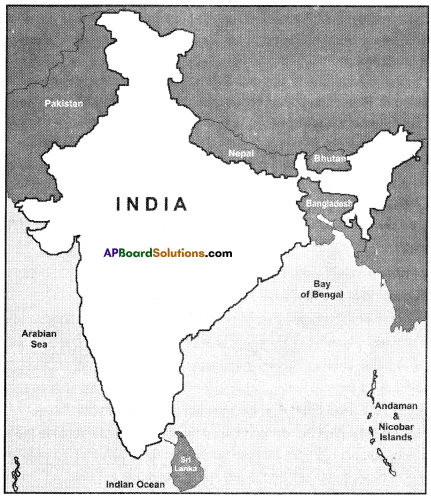 Both Pakistan and Bangladesh are our neighbouring countries.
Both Pakistan and Bangladesh are our neighbouring countries.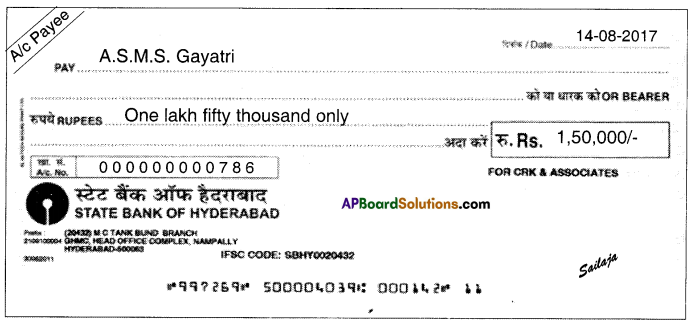




 Answer:
Answer: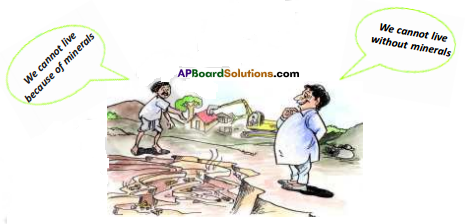 Answer:
Answer: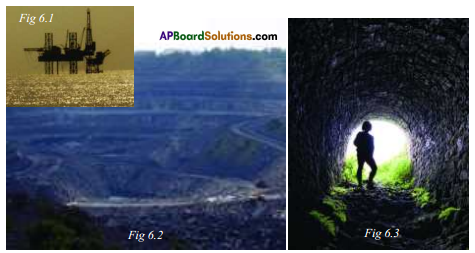

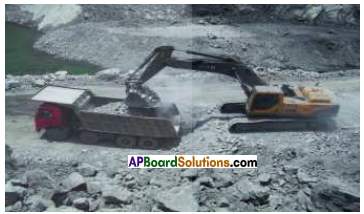
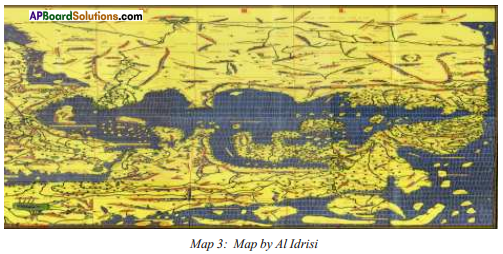 Note: To read this map we should turn it upside down.
Note: To read this map we should turn it upside down. Answer:
Answer: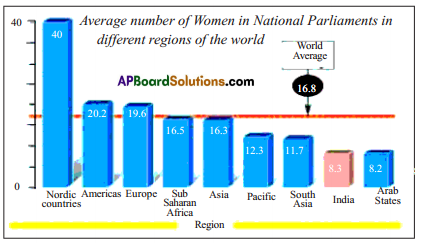 Based on the above information write an essay analysing the following aspects:
Based on the above information write an essay analysing the following aspects: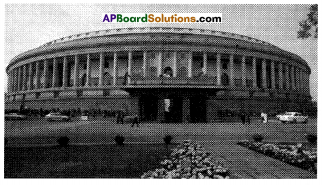

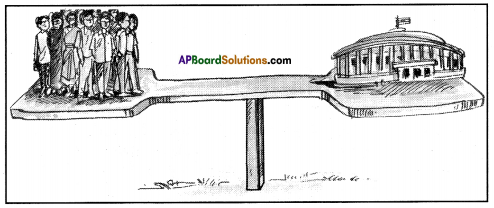 Answer:
Answer: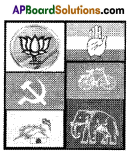



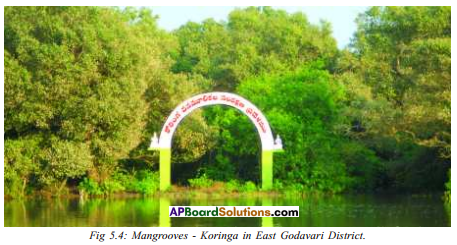
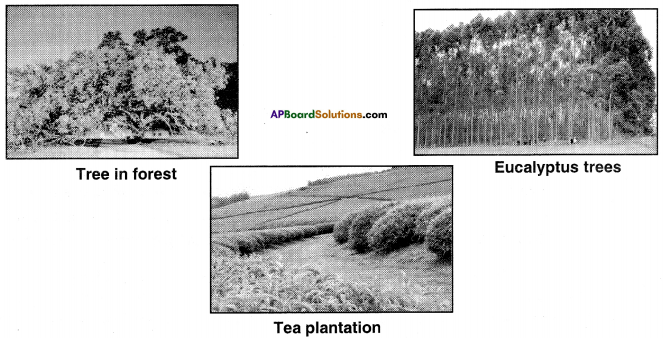
 Answer:
Answer: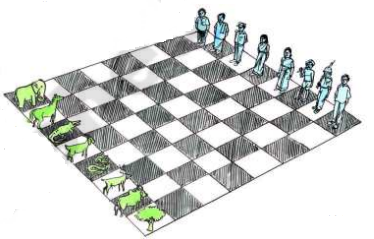 Write a caption on the above cartoon in the contest of forest. (Textbook Page No. 50)
Write a caption on the above cartoon in the contest of forest. (Textbook Page No. 50)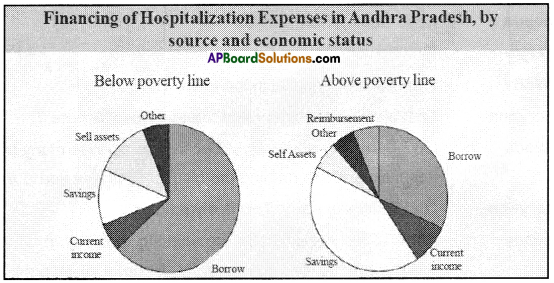 Answer:
Answer:
